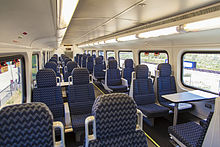mdrejhon
Senior Member
New nearly 200 page GO RER business case document released.
There is provisions to incrementally do this during GO RER to extend the assistive-platforms eventually to full platforms, with features that allow unassisted boarding for the disabled. Not full height 48-inch, but the current assisitive platforms extended to full platforms with features permitting unattended all-door wheelchair boarding.
The goal is basically the trainsets would be compatible with present low platforms and the current assistive platforms -- but stations (infills, and incremental upgrades) can have a full-length unmanned assistive-height platform rather than a one-door assistive platform.
Zurich provides a template where GO can cheaply slowly migrate to high(er) platforms. Also noteworthy is Utah's FrontRunner has level boarding with Bombardier BiLevels.
While not compatible with UPX or HSR platform height, this would be relatively incremental-friendly -- cheap because it doesn't have to be done right away -- and new infill stations only serviced by the EMUs can be full assistive-height.
There is provisions to incrementally do this during GO RER to extend the assistive-platforms eventually to full platforms, with features that allow unassisted boarding for the disabled. Not full height 48-inch, but the current assisitive platforms extended to full platforms with features permitting unattended all-door wheelchair boarding.
Metrolinx said:Platform Height: Raising platforms to allow level loading with EMUs should be explored. New bi-level EMUs can be designed for level boarding as on the Toronto subway. This allows passengers with wheelchairs, strollers and other mobility devices to load at any door, and can also make boarding of all passengers faster and safer. Minor platform height adjustment will be required, and perhaps other measures, to ensure compatibility with existing GO bi-level equipment which will continue in service. The Zurich S-Bahn is an established and successful system with bi-level EMU coaches where boarding occurs from the lowest levels of the train cars, achieving level boarding with an excellent standard of accessibility.
Metrolinx said:Assume continued use of low platforms.
Consider: 1) migrating toward full-length higher platforms, at the same height as the mini-platforms, for faster loading and shorter dwell times, and 2) purchasing new rolling stock with door and threshold designs, and with a threshold extension, as operating in Zurich that would allow unassisted boarding by – users who require step free access. See Figure 58. Zurich S-Bahn, serving a cold climate city and region, demonstrates excellent unassisted disabled passenger accessibility using new rolling stock mixed with old rolling stock.
The goal is basically the trainsets would be compatible with present low platforms and the current assistive platforms -- but stations (infills, and incremental upgrades) can have a full-length unmanned assistive-height platform rather than a one-door assistive platform.
Zurich provides a template where GO can cheaply slowly migrate to high(er) platforms. Also noteworthy is Utah's FrontRunner has level boarding with Bombardier BiLevels.
While not compatible with UPX or HSR platform height, this would be relatively incremental-friendly -- cheap because it doesn't have to be done right away -- and new infill stations only serviced by the EMUs can be full assistive-height.
Last edited:









